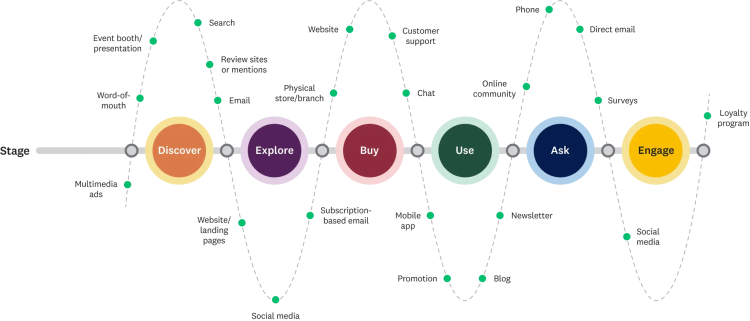25+ customer journey touchpoint examples and 10 tips to optimize
Discover how to identify and improve customer touchpoints with 25+ real-world examples and actionable tips.

Every business wants to improve the customer experience (CX)—and that requires a deep understanding of every customer touchpoint.
So how do you identify and improve key customer journey touchpoints and create a winning customer experience? We’ll explain customer touchpoint mapping, share customer touchpoint examples, and even walk you through how you can enhance your customer journey.
What are customer touchpoints?

Customer touchpoints are every interaction a customer or potential customer has with your brand—before, during, and after they purchase something from you. Identifying your touchpoints is the first step toward creating a customer journey map and ensuring your customers feel satisfied every time they come into contact with your brand.
There can be many touchpoints at each leg of your customer journey, and one customer’s initial interaction may not be the same as another’s.
For example, new customers may first interact with your business:
- On your website
- Through search engine queries
- Via advertisement
- On social media
- In your brick-and-mortar store
- On rating and review sites
- Through recommendations and word-of-mouth
This is why it’s important to understand who is interacting with your brand and when. With deep knowledge of your touchpoints, you can get a clearer picture of your target audience, build a successful Voice of the Customer (VoC) program, and make better business decisions for both your customers and your customer-facing teams.
See how Ryanair improves the customer journey with feedback
Discover how Ryanair optimizes customer touchpoints and boosts customer satisfaction with SurveyMonkey.
25 customer journey touchpoint examples
Since touchpoints encompass the entire customer journey, it can be helpful to consider examples broken down by stage: pre-purchase, during-purchase, and after-purchase.
Here’s a table that demonstrates the diversity of touchpoints across the customer experience, including both direct and indirect customer interactions.
| Before purchase | During purchase | After purchase |
| Social media posts, ads, and engagement | Sales representatives (in-store or virtual) | Order confirmation emails and tracking updates |
| Website blogs, landing pages, or educational resources | E-commerce product pages and shopping carts | Product delivery and unboxing experience |
| Word of mouth and referrals | Checkout and payment processes (online or in-store) | Customer support for troubleshooting or guidance |
| Online reviews and testimonials | In-store signage or promotional displays | Follow-up emails (e.g., satisfaction surveys) |
| Search engine results (organic and paid) | Customer service for purchase inquiries | Customer loyalty programs and rewards |
| Public relations efforts (media mentions, press releases) | Discounts, deals, or loyalty incentives | Post-purchase content (e.g., product tips or tutorials) |
| Digital and print advertisements | Product catalogs or menus | Social media engagement with customers |
| Email marketing campaigns introducing products/services | Promotions such as free shipping or limited-time offers | Community forums or user groups for customers |
| Reorder reminders or subscription notifications |
Now, let’s dig into these customer touchpoints a bit more to see how they relate and how they impact your customer experience and brand.
Pre-purchase touchpoints
Pre-purchase customer touchpoints occur at the awareness or consideration stage of the buying journey. They can really set the stage not just for your customer experience but also for your brand health.
After all, first impressions matter. If a potential customer's early interactions with your brand are positive, it’s good for your brand perception, and they’ll likely move along the sales funnel, from consideration to purchase, more quickly.
Examples of pre-purchase touchpoints:
- Social media posts, ads, and engagement
- Blogs, landing pages, or educational resources
- Word of mouth and referrals
- Online reviews and testimonials
- Search engine results (organic and paid)
- Public relations efforts (media mentions, press releases)
- Digital and print advertisements
- Email marketing campaigns introducing products/services
Purchase touchpoints
Is your customers’ purchase experience everything they need and expect? The only way to know is to examine your purchase touchpoints, the interactions customers have when they are either getting ready to make a purchase or immersed in the process.
The customer touchpoints at this stage can determine whether someone will actually follow through and make a purchase—and whether they become a repeat, happy customer or start looking to your competitors for a better experience.
Examples of purchase touchpoints:
- Sales representatives (in-store or virtual)
- E-commerce product pages and shopping carts
- Checkout and payment processes (online or in-store)
- In-store signage or promotional displays
- Customer service for purchase inquiries
- Discounts, deals, or loyalty incentives
- Product catalogs or menus
- Promotions such as free shipping or limited-time offers
Post-purchase touchpoints
Repeat after us: a purchase isn’t the finish line in the customer journey. The touchpoints that come after a purchase experience are vital for staying connected with a customer and building on that relationship. Post-purchase touchpoints extend indefinitely and include interactions with both repeat purchasers and new customers.
Examples of post-purchase touchpoints:
- Order confirmation emails and tracking updates
- Product delivery and unboxing experience
- Customer support for troubleshooting or guidance
- Follow-up emails (e.g., satisfaction surveys, “thank you” messages)
- Customer loyalty programs and rewards
- Post-purchase content (e.g., product tips or tutorials)
- Social media engagement with customers
- Community forums or user groups for customers
- Reorder reminders or subscription notifications
Keep in mind, customer touchpoints can vary significantly from one company to another and from one industry to another. Examples of customer touchpoints for a retail company with brick-and-mortar stores might include the in-person browsing experience. On the other hand, a tech company in the SaaS industry would likely have more digital customer touchpoints.
Why is it important to identify customer journey touchpoints?
The benefits of knowing your customer touchpoints include:
Clarifying the customer journey
Understanding your customer journey touchpoints will help you get a comprehensive view of your customer journey and customer experience: what it’s actually like to move from consideration to purchase and beyond, plus how customers feel at each of those stages. That way, you can zoom in on the details of their experience and where you can improve key touchpoints.
Building stronger customer relationships
As we mentioned earlier, successful customer touchpoints have a long-term impact on your customer satisfaction and brand loyalty. Knowing your touchpoints inside and out will help you replicate great customer interactions and improve unsatisfying ones before they become a problem.
Increasing conversion rates
When you map the customer journey, it helps you pinpoint specific areas where customers may encounter challenges or dissatisfaction. Pain points like a frustrating checkout process or misleading promotions won’t do your conversion rate any favors—but by identifying them, you can prioritize fast and meaningful fixes.
Gathering insights for targeted marketing
Knowing where customers interact with your brand allows for optimizing those interactions. This could mean everything from making sure you’re investing your ad spend in the right social media platform to automating check-in support communication three months after a customer makes a purchase.
Improving customer retention
People won’t stick with your brand if your customer onboarding is flawed--or nonexistent. By recognizing and improving ineffective post-purchase touchpoints, you can significantly boost your customer retention rate and show existing customers that you value their business.
Identifying opportunities for innovation
Want to drive continuous improvement for your organization? By regularly monitoring and adapting customer touchpoints, you can make sure your company is staying agile and responsive to evolving customer expectations. For instance, if more and more customers want to interact with customer service chatbots as they’re browsing, you can focus on making that touchpoint modern, helpful, and fast.
How to identify customer touchpoints and optimize them
What are your customer touchpoints? They’re different for every business, so you’ll have to determine what yours are by analyzing your customer interactions.
Here’s how to identify customer touchpoints and optimize your customer touchpoint strategy.
Identify your target audience
Identifying your target audience is crucial in understanding their needs, preferences, and behaviors. By understanding your audience, you can tailor your customer touchpoints to meet their specific needs and expectations. Here are some steps to identify your target audience:
- Conduct market research and analyze customer data
- Create buyer personas to represent your ideal customers
- Analyze customer feedback and reviews
- Use social media and online analytics to understand customer behavior
Think about your target customers and their needs
Use market research insights to examine the types of consumers who are likely to purchase from you. Think about what initial touchpoints would be appropriate for your customers.
For example, if your target market is expectant mothers, word of mouth and parenting blogs might be a significant early touchpoint for your brand. And you might consider adding promo codes and coupons to your social media marketing or starting a referral program to broaden your touchpoints and tap into a loyal customer base.
Put yourself in the customer’s shoes
Because there are so many ways for customers to experience your brand, figuring out all your current touchpoints can feel daunting. But you can make this task more manageable by stepping out of your role and into the customer’s shoes.
Ensure you have a pen and paper handy to take notes as you put yourself in the customer mindset. Once you’re enmeshed in that point of view, ask yourself where you go (and how) when you:
- Have a problem that needs solving
- Discover the product or business that will solve that problem
- Make your purchase decision
- Encounter the business after your purchase
You could also ask existing customers to walk you through their experience with your brand or ask these same customer journey questions in a survey.
Review how customers engage with your business
Which touchpoints really resonate with customers? You can use a content strategy survey to determine where people prefer to engage with your brand or brands like yours.
You should also pull data on your current customer channels. What’s the click-through rate for your email marketing? Or the engagement rate for your online advertising or social media posts? Having insights on your current strategies and performance will help you take stock of current touchpoints and your customer journey as a whole.
Map the customer journey
Customer journey mapping is a visual representation of all the touchpoints a buyer has with your organization. It’s also a great way to chart the buying process for a particular customer segment purchasing a specific product or service. Since it visually represents touchpoints, a customer journey map is helpful for getting a bird' s-eye view of the customer experience.
Look at how a typical customer from the segment:
- Identifies a problem
- Researches an answer
- Learns about your business
- Engages with your company
- Makes a purchase
- Interacts after the purchase
Repeat this exercise for different segments and key personas.
Categorize your customer touchpoints
Take the touchpoints you’ve identified on your customer journey map and categorize them as before, during, and after purchase. This strategy will help you identify areas that are working well and areas that need improvement.
You could also categorize touchpoints as products, interactions, messages (manuals, advertising, etc.), and settings (where you sell products). Or determine your categories based on what makes sense for your specific brand and products.
Review frequently
Your customer touchpoint map is a living document and will need ongoing updates as you introduce new marketing initiatives and purchasing paths. For the best CX, make sure you continue to review and refine your touchpoints and how customer interact with your brand.
How to improve customer journey touchpoints (10 tips for success)
Knowing your touchpoints only takes you halfway. To increase customer satisfaction, you need to ensure that each touchpoint leads to a good customer experience and that the journey as a whole meets customers’ expectations.
1. Collect and analyze feedback with customer touchpoint surveys
The best way to find out how your customers are faring at each touchpoint is to ask them.
When you’ve identified and mapped customer touchpoints, use customer surveys to evaluate critical engagement moments. You’ll find out what’s working, where interactions are subpar, and whether there are smaller touchpoints that your marketing efforts have overlooked.
You can also gather core customer experience metrics like Customer Satisfaction Score (CSAT), Net Promoter Score (NPS®), and Customer Effort Score (CES). This quantifiable data will help keep customers happy and track progress as you implement CX improvements.
Related reading: The ultimate guide to running a customer feedback program
2. Act on customer feedback
Acting on customer feedback is essential for demonstrating that you value and care about your customers’ opinions. By responding to feedback, you can:
- Address customer concerns and issues
- Improve customer satisfaction and loyalty
- Identify areas for improvement and optimize customer touchpoints
- Enhance your brand reputation and credibility
Here are some steps to act on customer feedback:
- Respond promptly and personally to customers
- Analyze customer feedback to identify patterns and trends
- Implement changes and improvements based on customer feedback
- Communicate changes and improvements to customers and stakeholders
3. Prioritize customer touchpoint improvements based on data
Take a look at the frustrations and challenges that come up the most in your customer feedback. Working on the area that receives the most complaints is always a good idea.
Maybe your customer support agents didn’t resolve a query. Maybe your product arrived late or in bad condition. Perhaps some people think your website is challenging to navigate. Let the data tell you what customer touchpoint you should work on first.
Remedying issues this way will improve your brand over time and help ensure you address urgent problems quickly. Plus, when you demonstrate that your customers’ feedback matters, you’ll pave the way for higher customer satisfaction, loyalty, and lifetime value.
4. Personalize experiences
Audit your touchpoints, especially customer communications, to see where you may be missing opportunities for more personalization. Are you sending curated emails based on customers’ purchase history with your brand? Are your customer service reps addressing customers by name? Even small touches can go a long way toward boosting customer satisfaction.
5. Optimize for omnichannel experiences
Have you been looking at individual customer touchpoints in a vacuum? Your customer experience is the sum of its parts, so look at your entire journey. Customers don’t think in channels; they expect a seamless experience whether they’re browsing your website, chatting with support, or reading an email.
Make sure their journey:
- Keeps messaging and branding consistent
- Connect the dots between interactions
- Make it easy to switch between touchpoints and channels
Learn how you can successfully leverage Customer Effort Score and create a frictionless customer journey.
6. Leverage technology
The most effective way of addressing and improving customer satisfaction is to ensure your data is in one place. If you have several disconnected tools measuring different areas of the customer experience, things could fall through the cracks.
Integrate your CX data with your company’s chosen CRM to rapidly build a 360-degree view of your customer experience. Connecting your CRM to SurveyMonkey lets you trigger feedback surveys at key customer touchpoints—so you don’t miss a beat or an insight.
An integrated approach will help your business gather more data, utilize customer feedback, and make data-driven decisions.
7. Train employees
Customer service teams are often one of your company's most important customer touchpoints. When a customer needs advice, or something goes wrong, your reps will be their first point of contact.
Investing in customer service team training can increase the quality of support your customers receive. Training can focus on soft skills like communication while building your team’s knowledge of internal documents and solutions. The better prepared your employees are, the better their customer interactions will be.
It’s useful to integrate pre-, during-, and post-training surveys to give your employees the chance to provide feedback on training and development. Just like with customer experience feedback surveys, getting feedback from your employees will help you see what’s working and how you can enhance their experience.
8. Ensure consistent branding
If your social media posts, online checkout page, and post-purchase thank you email look like different companies crafted them, you’ve got a problem. Ensure your customer touchpoints feel connected and consistent, from the messaging and brand voice to the visuals and the user experience.
9. Monitor and update regularly
We’ve said it before, and we’ll say it again: Your customer touchpoints are ever-changing. Reviewing your touchpoints and customer journey maps should be baked into your regular processes.
10. Continue honing your customer touchpoint strategy
Creating a customer touchpoint strategy involves identifying, planning, and optimizing customer touchpoints to meet customer needs and expectations. But it also involves ensuring you’re consistently evolving and evaluating your strategy.
Here are a few tips to keep improving your strategy:
- Regularly review customer touchpoints to ensure they align with evolving customer needs.
- Analyze feedback and performance data to identify friction points and opportunities for enhancement.
- Reassess priorities based on customer value, business goals, and emerging trends.
- Optimize existing touchpoints by refining messaging, streamlining processes, and leveraging new technology.
- Track effectiveness through key metrics and customer insights, adjusting as needed to maintain relevance and impact.
You can ensure your customer touchpoints drive engagement, satisfaction, and long-term loyalty by regularly fine-tuning your approach.
Improve your customer journey touchpoints
Your customers’ experience with your brand begins before their first interaction. Identify touchpoints before, during, and after each sale, and use these to create a customer touchpoint map. Get feedback at each touchpoint to increase customer satisfaction, experience, and retention.
Start getting feedback from customer touchpoints today with SurveyMonkey. We look forward to helping you get started.
Net Promoter, Net Promoter Score, and NPS are trademarks of Satmetrix Systems, Inc., Bain & Company, Inc., and Fred Reichheld.
Discover more resources

Solutions for your role
SurveyMonkey can help you do your job better. Discover how to make a bigger impact with winning strategies, products, experiences, and more.

Why are surveys important in research?
Surveys are important in research because they offer a flexible and dependable method of gathering crucial data. Learn more today.

NPS surveys: Best practices for high response rates
Learn NPS survey best practices to drive high response rates by improving survey processes.

23 ways to increase CSAT response rates
It's hard to improve your customer satisfaction scores without respondents. Get SurveyMonkey's best actionable tips to improve your response rate.